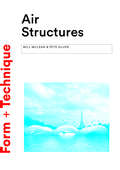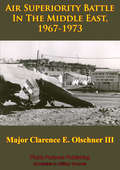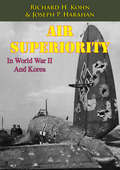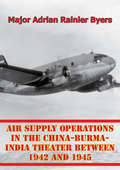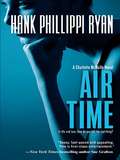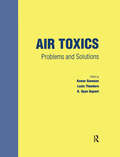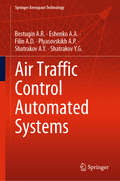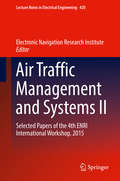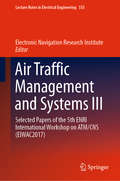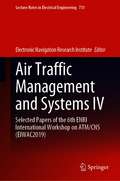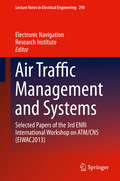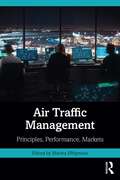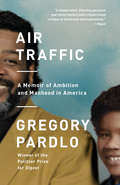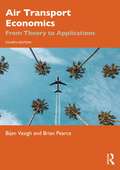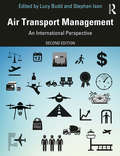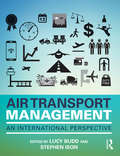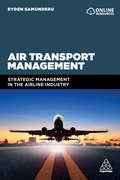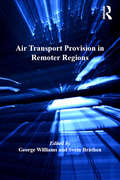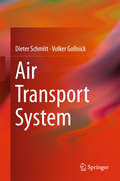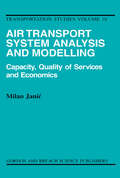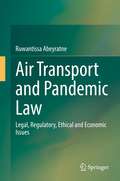- Table View
- List View
Air Structures (Form + Technique)
by Peter Silver William McLean Pete SilverAir can be used in a variety of ways to make lightweight, flexible structures. It can be used to make inflatable structures, mobile structures, and temporary buildings, it can also activate movable elements and act as a means of constructing buildings that would be impossible with conventional construction methods.This book looks at every facet of the subject, examining the different types of air structure: super pressure buildings, air beam structures, buoyant structures, inflatable structures, and many more. It also looks at the construction methods that use air, such as air-inflated steel, aerated concrete and blow moulding. Filled with photographs, models, drawings, and diagrams, this is the ideal book for curious students, designers and architects.
Air Superiority Battle In The Middle East, 1967-1973
by Major Clarence E. Olschner IIIThis paper is an historical study of the strategy, tactics, and weapons employed by Israel, Egypt, and Syria in the battle for air superiority from 1967 through 1973. The study is developed chronologically beginning with the 1967 War, through the War of Attrition, and ending with the cease-fire in the 1973 War. It has been compiled from an extensive review of unclassified, primarily secondary, unofficial sources. The paper concludes that, in a mid-intensity war with modern air forces and air defense forces: 1) The achievement of strategic, tactical, and/or technological surprise can significantly influence the battle for air superiority, 2) Missiles have demonstrated the capability to significantly influence the air superiority battle in surface-to-air, air-to-air, and air-to-ground operations, 3) Air superiority can be achieved over the modern battlefield only by defeating both surface-to-air and air-to-air capabilities of the enemy, 4) The achievement of air superiority over the battle area requires the combined efforts of air and land forces of which long range artillery may be the most effective weapon for the suppression of surface-based air defenses.
Air Superiority In World War II And Korea [Illustrated Edition]
by Joseph P. Harahan Richard H. KohnIncludes over 20 illustrations.In November 1981, Lt. Gen. Hans H. Driessnack, Assistant Vice Chief of Staff, asked the Historical Program to assemble a small number of retired officers for a group oral history interview. General Driessnack believed that in reminiscing together, these officers would recall incidents and experiences that might otherwise go unrecorded; by exchanging ideas and questioning each other--in effect, interviewing each other--they would recall material that would be of interest and importance to the Air Force today. General Driessnack also suggested selecting retired officers from the senior statesman conference, a gathering every spring at which retired four-star generals are briefed on Air Force issues and then discuss them with contemporary Air Force leaders.The result is the following interview. The four participants--Gen. James Ferguson, Gen. Robert M. Lee, Gen. William W. Momyer, and Lt. Gen. Elwood R. "Pete" Quesada--gathered on May 21, 1982, around a table in the Vandenberg room at the Bolling Air Force Base Officers' Club. For approximately two and one half hours they responded to questions sent to them earlier and discussed air superiority in World War II and Korea. Their discussions ranged far and wide: flying in the pre-World War II Army Air Corps, campaigning in North Africa and Western Europe in World War II, planning and participating in the Normandy invasion, using secret intelligence supplied by Ultra, struggling to codify tactical air doctrine in the post-war years, fighting the air battle in Korea, and thinking about the general problem of air superiority throughout their careers. This collective interview is not history but the source material on which history rests; it is a memoir, a first-hand account by air leaders who flew, fought, and commanded tactical air forces in combat.
Air Supply Operations In The China-Burma-India Theater Between 1942 And 1945
by Major Adrian Rainier ByersThe USAAF responded to the requirement to keep China engaged against Japan by conducting two distinct air supply operations, a tactical air supply mission to Burma and a strategic air supply effort over the Himalayas to China. The tactical air supply effort to Burma supported offensive combat operations and the construction of the Ledo Road, while the Hump airlift directly contributed to the American strategic objective. Despite Stilwell's stubborn commitment to the Ledo Road as the main effort to supply the Chinese and to the necessary use of tactical air supply to support this and other ground operations in Burma, the key contribution to the success of keeping China in the war against Japan was ultimately the strategic air supply missions over the Hump. This thesis reviews how the operational airlift efforts within the CBI supported both efforts and examines the challenges, processes, and development of air supply. The fundamental question associated with this effort concerns how the USAAF responded to seemingly competing air supply requirements in the CBI Theater in order to keep China in the war against Japan.
Air That Kills: India's Pollution Problem (Fountas & Pinnell Classroom, Guided Reading Grade 5)
by Susan StubbsTOXIC AIR In some Indian cities, people hurry through the streets, gasping for air. They have trouble breathing because of the air pollution, which is so bad that it can cause illness, and even death. NIMAC-sourced textbook
Air Time
by Hank Phillippi RyanWhen savvy TV reporter Charlotte McNally enters the glamorous world of high fashion, she soon discovers that when the purses are fake--the danger is real. And no one can be trusted!Now Charlotte can't tell the real from the fake as she goes undercover to bring the couture counterfeiters to justice--and in her struggle to answer an all-important, life-changing question from a certain handsome professor.... The one thing Charlotte knows for sure is that the wrong choice could be the last decision she ever makes!
Air Toxics: Problems and Solutions
by Kumar GanesanThis timely new workbook is the result of a year-long effort by a group of university professors who first met at Montana Tech during the summer of 1994 for a college faculty workshop. The workshop was funded by the National Science Foundation's support for those faculty developing courses in the newly emerging field of air toxics. Part I of the book contains over 100 problems dealing with a variety of topics in this area. Part II provides detailed solutions. The problems and solutions provided will become a useful resource for the training of engineers and scientists who are or soon will be working in the field.
Air Traffic Control Automated Systems (Springer Aerospace Technology)
by Shatrakov A.Y. Shatrakov Y.G. Bestugin A.R. Eshenko A.A. Filin A.D. Plyasovskikh A.P.This book highlights operation principles for Air Traffic Control Automated Systems (ATCAS), new scientific directions in design and application of dispatching training simulators and parameters of ATCAS radio equipment items for aircraft positioning. This book is designed for specialists in air traffic control and navigation at a professional and scientific level. The following topics are also included in this book: personnel actions in emergency, including such unforeseen circumstances as communication failure, airplane wandering off course, unrecognized aircraft appearance in the air traffic service zone, aerial target interception, fuel draining, airborne collision avoidance system (ACAS) alarm, emergency stacking and volcanic ash cloud straight ahead.
Air Traffic Control: Human Performance Factors
by Anne R. Isaac Bert RuitenbergFrom the Foreword by Captain Daniel Maurino, ICAO: '...Air Traffic Control...will remain a technology-intensive system. People (controllers) must harmoniously interact with technology to contribute to achieve the aviation system’s goals of safe and efficient transportation of passengers and cargo...This book...considers human error and human factors from a contemporary and operational perspective and discusses the parts as well as the whole...I hope you enjoy reading it as much as I did.' The motivation for writing this book comes from the author’s long standing belief that the needs of Air Traffic Service personnel are inadequately represented in the aviation literature. There are few references to air traffic control in many of the books written for pilots and about pilots and this is also observed at the main international conferences. In line with the ICAO syllabus for human factors training for air traffic controllers, the book covers the main issues in air traffic control, with regard to human performance: physiology including stress, fatigue and shift work problems; psychology with emphasis on human error and its management, social psychology including issues of communication and working in teams, the environment including ergonomic principles and working with new technologies and hardware and software issues including the development of documentation and procedures and a study of the changes brought about by advanced technologies. Throughout the text there are actual examples taken from the air traffic control environment to illustrate the issues discussed. A full bibliography is included for those who want to read beyond these issues. It has been written for all in air traffic services, from ab initio to the boardroom; it is important that the men and women in senior management positions have some knowledge and awareness of the fundamental problems that limit and enhance human performance.
Air Traffic Controller Staffing in the En Route Domain: A Review of the Federal Aviation Administration's Task Load Model
by National Research Council of the National AcademiesTRB Special Report 301: Air Traffic Controller Staffing in the En Route Domain: A Review of the Federal Aviation Administration's Task Load Model examines the structure, empirical basis, and validation methods of an Federal Aviation Administration model that estimates the time controllers spend performing tasks when handling en route traffic. The model's task load output is being used to inform workforce planning. The committee that developed the report concluded that the model is superior to past models because it takes into account traffic complexity when estimating task load. However, the report recommends that more operational and experimental data on task performance be obtained to establish and validate many key model assumptions, relationships, and parameters.
Air Traffic Controllers
by Michael Beer Bert A. SpectorOn August 3, 1981 President Ronald Reagan terminated 12,000 air traffic controllers, members of the Professional Air Traffic Controllers Organization, for violating their no-strike oath. Provides background on the human resources policies and practices of the Federal Aviation System and information concerning the negotiations and impact of the terminations.
Air Traffic Management and Systems II: Selected Papers of the 4th ENRI International Workshop, 2015 (Lecture Notes in Electrical Engineering #420)
by Electronic Navigation Research InstituteThis book is a compilation of selected papers from the 4th ENRI International Workshop on ATM/CNS (EIWAC2015). The work focuses on novel techniques for aviation infrastructure in air traffic management (ATM) and communications, navigation, surveillance, and informatics (CNSI) domains. The contents make valuable contributions to academic researchers, engineers in the industry, and regulators of aviation authorities. As well, readers will encounter new ideas for realizing a more efficient and safer aviation system.
Air Traffic Management and Systems III: Selected Papers of the 5th ENRI International Workshop on ATM/CNS (EIWAC2017) (Lecture Notes in Electrical Engineering #555)
by Electronic Navigation Research InstituteThis proceedings provides novel concepts and techniques for air traffic management (ATM) and communications, navigation, and surveillance (CNS) systems. The volume consists of selected papers from the 5th ENRI International Workshop on ATM/CNS (EIWAC2017) held in Tokyo in November 2017, the theme of which was “Drafting Future Skies”. Included are key topics to realize safer and more efficient skies in the future, linked to the integrated conference theme consisting of long-term visions based on presentations from various fields. The proceedings is dedicated not only to researchers, academicians, and university students, but also to engineers in the industry, air navigation service providers (ANSPs), and regulators of aviation.
Air Traffic Management and Systems IV: Selected Papers of the 6th ENRI International Workshop on ATM/CNS (EIWAC2019) (Lecture Notes in Electrical Engineering #731)
by Electronic Navigation Research InstituteThis book provides novel concepts and techniques for air traffic management (ATM) and communications, navigation, and surveillance (CNS) systems. The book consists of selected papers from the 6th ENRI International Workshop on ATM/CNS (EIWAC2019) held in Tokyo in October 2019, the theme of which was “Exploring Ideas for World Aviation Challenges”. Included are key topics to realize safer and more efficient skies in the future, linked to the integrated conference theme consisting of long-term visions based on presentations from various fields. The book is dedicated not only to researchers, academicians, and university students, but also to engineers in the industry, air navigation service providers (ANSPs), and regulators of aviation.
Air Traffic Management and Systems: Selected Papers of the 3rd ENRI International Workshop on ATM/CNS (EIWAC2013) (Lecture Notes in Electrical Engineering #290)
by Kazuo Yamamoto Electronic Navigation Research Institute StaffThe Electronic Navigation Research Institute (ENRI) held its third International Workshop on ATM / CNS in 2013 with the theme of "Drafting the future sky". There is worldwide activity taking place in the research and development of modern air traffic management (ATM) and its enabling technologies in Communication, Navigation and Surveillance (CNS). Pioneering work is necessary to contribute to the global harmonization of air traffic management and control. At this workshop, leading experts in research, industry and academia from around the world met to share their ideas and approaches on ATM/CNS related topics.
Air Traffic Management: Principles, Performance, Markets
by Marina EfthymiouThis book addresses each of the Air Navigation Services' five broad categories of services provided to air traffic during all phases of operation: air traffic management (ATM), communication, navigation and surveillance services (CNS), meteorological services for air navigation (MET), aeronautical information services (AIS) and search and rescue (SAR). This book is designed for working professionals in Air Transport Management, but also undergraduate and postgraduate students studying air transport management and aeronautical engineering. It will also be very helpful for the training of air traffic control officers (ATCOs). The book does not require any prior (specialist) knowledge as it is an introduction to air navigation service provider (ANSP) business. There is very little literature available that gives a detailed appreciation of the complexities, potential risks and issues associated with the provision of air navigation services. The role of this book is to fill this significant gap with a comprehensive, in-depth study of the management principles related to ANSPs. This is particularly timely given recent ATC developments in Europe, USA and New Zealand. Airlines and airports rely on the ANSPs for the management of air traffic. Hence, air navigation services (ANS) provision is considered as a core element for air transportation.
Air Traffic: A Memoir of Ambition and Manhood in America
by Gregory PardloFrom the beloved Pulitzer Prize-winning poet: an extraordinary memoir and blistering meditation on fatherhood, race, addiction, and ambition. Gregory Pardlo's father was a brilliant and charismatic man--a leading labor organizer who presided over a happy suburban family of four. But when he loses his job following the famous air traffic controllers' strike of 1981, he succumbs to addiction and exhausts the family's money on more and more ostentatious whims. In the face of this troubling model and disillusioned presence in the household, young Gregory rebels. Struggling to distinguish himself on his own terms, he hustles off to Marine Corps boot camp. He moves across the world, returning to the United States only to take a job as a manager-cum-barfly at his family's jazz club. Air Traffic follows Gregory as he builds a life that honors his history without allowing it to define his future. Slowly, he embraces the challenges of being a poet, a son, and a father as he enters recovery for alcoholism and tends to his family. In this memoir, written in lyrical and sparkling prose, Gregory tries to free himself from the overwhelming expectations of race and class, and from the tempting yet ruinous legacy of American masculinity. Air Traffic is a richly realized, deeply felt ode to one man's remarkable father, to fatherhood, and to the frustrating yet redemptive ties of family. It is also a scrupulous, searing examination of how manhood can be fashioned in our cultural landscape.
Air Transport Economics: From Theory to Applications
by Brian Pearce Bijan VasighAir Transport Economics: From Theory to Applications uniquely merges the institutional and technical aspects of the aviation industry with their theoretical economic underpinnings. Its integrative approach offers a fresh point of view that will find favor with many students of aviation. This fourth edition has undergone extensive updates throughout. It features new material addressing the impact of COVID-19 on the air transport industry, and the efforts made by both the industry and governments to facilitate recovery. A new chapter examines the impact of air transport on climate change and how government policies to address this issue could reshape the industry. Additionally, alongside expanded coverage of revenue management and pricing decisions, this fourth edition incorporates case studies that give real-world examples to reflect current industry practices. Moreover, there is a discussion of the latest computer applications that enhance the effectiveness of the new techniques. This book offers a self-contained theory and applications-oriented text for individuals aspiring to enter the aviation industry as a practicing professional in the management area. It will be of the greatest relevance to undergraduate and graduate students aiming to acquire a comprehensive grasp of the economics of the aviation industry. The review questions at the end of each chapter have been expanded considerably, and an online assignment has been introduced for each chapter. This book will also appeal to many professionals who seek an accessible and practical explanation of the underlying economic forces that shape the industry.
Air Transport Management: An International Perspective
by Lucy BuddAir Transport Management: An International Perspective provides in-depth instruction in the diverse and dynamic area of commercial air transport management. The 2nd edition has been extensively revised and updated to reflect the latest developments in the sector. The textbook includes both introductory reference material and more advanced content so as to provide a solid foundation in the core principles and practices of air transport management. This 2nd edition includes a new chapter on airline regulation and deregulation and new dedicated chapters focusing on aviation safety and aviation security. Four new contributors bring additional insights and expertise to the book. The 2nd edition retains many of the key features of the 1st edition, including: • A clearly structured topic-based approach that provides information on key air transport management issues including: aviation law, economics; airport and airline management; finance; environmental impacts, human resource management; and marketing; • Chapters authored by leading air transport academics and practitioners worldwide which provide an international perspective; • Learning objectives and key points which provide a framework for learning; • Boxed case studies and examples in each chapter; • Keyword definitions and stop and think boxes to prompt reflection and aid understanding of key terms and concepts. Designed for undergraduate and postgraduate students studying aviation and business management degree programmes and industry practitioners seeking to expand their knowledge base, the book provides a single point of reference to the key legal, regulatory, strategic and operational concepts and processes that shape the form and function of the world’s commercial air transport industry.
Air Transport Management: An international perspective
by Lucy Budd Stephen IsonCommercial air transport is a global multimillion dollar industry that underpins the world economy and facilitates the movement of over 3 billion passengers and 50 million tonnes of air freight worldwide each year. With a clearly structured topic-based approach, this textbook presents readers with the key issues in air transport management, including: aviation law and regulation, economics, finance, airport and airline management, environmental considerations, human resource management and marketing. The book comprises carefully selected contributions from leading aviation scholars and industry professionals worldwide. To help students in their studies the book includes case studies, examples, learning objectives, keyword definitions and ‘stop and think’ boxes to prompt reflection and to aid understanding. Air Transport Management provides in-depth instruction for undergraduate and postgraduate students studying aviation and business management-related degrees. It also offers support to industry practitioners seeking to expand their knowledge base.
Air Transport Management: Strategic Management in the Airline Industry
by Eyden SamunderuThe aviation industry is a major driver of world trade. As global markets and economies are constantly evolving, practitioners and academics need more quality information and a broader perspective of aviation management rather than just silo-based knowledge, particularly if they wish to move up the management ladder and progress. Air Transport Management presents the dynamic shifts which have influenced structural changes in the aviation industry, such as the emergence of low cost carriers. These changes have transformed the market, leading to deregulation and consolidation. The author provides a viable road map aimed at giving students and managers in the aviation industry a rigorous understanding on how to manage strategically in complex and turbulent market conditions. Air Transport Management examines the airline industry structure in terms of entry barriers, competition dynamics and competing business models. With the inclusion of fascinating case studies, this handbook assesses different business models used by international companies and proposes best fit management practices which airlines should follow in order to survive. Online supporting resources include PowerPoints of lesson plans.
Air Transport Provision in Remoter Regions
by Svein BråthenThis book stems from a series of biennial conferences devoted to issues affecting air-transport provision in remoter regions that have been organized by the Centre for Air Transport in Remoter Regions at Cranfield University. The primary aim of the conferences has been to provide an opportunity for those responsible for operating, managing, regulating and financing air transport services and associated infrastructure in these areas to be informed of the latest best-practice initiatives, to contrast different policy approaches and to debate potential solutions to perennial problems. Remoter regions has been a neglected area of air transport, as much of the focus of public and media attention is on the larger airlines, airports and aircraft. While the number of large airports in the world is in the hundreds, there are many thousands of smaller airports providing communities all over the globe with vital air links. More often than not these services and the airports to which they are operated are loss making and require subsidies to sustain them. There are therefore many more interested parties involved in both providing and deciding issues relating to the provision of air transport in these situations, most especially central, regional and local governments who are charged with financing these activities. The book contains 17 chapters from experts in remote-region air transport, within the following 5 sections: - Key economic and socio-economic issues - Subvention mechanisms - Route development initiatives - Infrastructure provision - Issues affecting the provision of air services in remoter regions.
Air Transport System (Research Topics In Aerospace Ser.)
by Dieter Schmitt Volker GollnickThe book addresses all major aspects to be considered for the design and operation of aircrafts within the entire transportation chain. It provides the basic information about the legal environment, which defines the basic requirements for aircraft design and aircraft operation. The interactions between airport, air traffic management and the airlines are described. The market forecast methods and the aircraft development process are explained to understand the very complex and risky business of an aircraft manufacturer. The principles of flight physics as basis for aircraft design are presented and linked to the operational and legal aspects of air transport including all environmental impacts. The book is written for graduate students as well as for engineers and experts, who are working in aerospace industry, at airports or in the domain of transport and logistics.
Air Transport System Analysis and Modelling (Transportation Studies)
by Milan JanicPresenting a comprehensive coverage, Air Transport System Analysis and Modelling is a unique text dealing with the analysis and modelling of the processes and operations carried out in all three parts of the air transport system, namely, airports, air traffic control and airlines. Seen from a planners point of view, this book provides insights into
Air Transport and Pandemic Law: Legal, Regulatory, Ethical and Economic Issues
by Ruwantissa AbeyratneThe book discusses legal, ethical, economic and trade aspects of the Pandemic as it affects air transport. It commences with the chronology of the virus spread and examines the various facets of human existential perspectives affected by the pandemic. Following this background is an evaluation of the effect on trade and economics, as well as the legal and regulatory structure concerning communicable diseases applicable to air transport. There is also a detailed discussion on legal liabilities and responsibilities of the State, airlines, airports and public both collectively and individually in coping with the pandemic against the backdrop of public health and the law. The Conclusion contains various recommendations on proactive measures that could be taken to ensure the establishment of a credible and effective legal and regulatory system to combat future pandemics.
